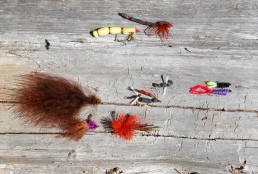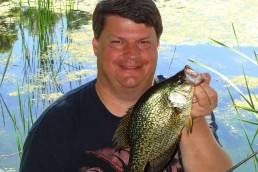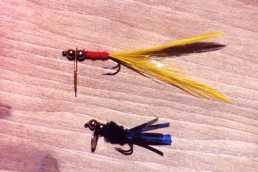My Own Fab Five: Homemade Flies that Rarely Fail Me
SHARE THIS POST
Maybe it’s the penny-pinching simplistic side of me that likes fly fishing. With just a minimum of materials, a lot of imagination and a couple minutes of time, I can concoct a reasonable facsimile of something that a fish might find attractive. When I’m done, I can carry about a thousand of these little offerings in my back pockets.
Fishers are experimenters and maybe fly fishers more than most. We are always looking for a better fly but for any species of fish I always like to have some basic fallback flies stuck is a corner of my fly box. The following list is certainly open to debate but I have found that when all else fails one of the following will catch me something. I guess will never be famous because I can’t think of clever names for my flies, so forgive my rather mundane tags for these flies.
The wooly thing
This is one of the easiest flies to tie and to fish; just wrap yarn or chenille around the shank. You can make them thin or thick. If you want to get fancy, use two different colors such as black and yellow like a bee. A short red tail of yarn or tinsel can add some flash.
Cotton yarn will absorb water and as you fish it will change from a dry fly to a sinking fly. Most of the time this is fished as a wet fly but it can be made to be a floater with hydrophobic yarn or by using a floatant. This also is fished on the slow side because it more resembles a bug than a fish.
The marabou whatchamacallit
This is a Wooly with flair. One method to tie this is to just wrap a piece of marabou around the shank. Make sure that the shaft of the feather is limber enough to wrap easily and tightly around the shank of the hook. A second method is to use the cut off the fibers and use them as dubbing. This makes a more compact fly with hundreds of legs/antenna sticking out. A third way is to glue and tie the shaft of the feather along the top of the shank. This makes for a more fishlike appearance.
This is strictly a wet fly, and I do mean wet. A heavier weight rod is needed to move this wet mass of feather through the air. In the water, however, it glides with almost no resistance.
A short, jerky retrieve makes it undulate and swim through the water. The marabou slicks down into a compact shape on the retrieve, but flairs out into a larger mass on the stop.
Are you enjoying this post?
You can be among the first to get the latest info on where to go, what to use and how to use it!
The ant
What else is there to say: ants are omnipresent. They get blown off leaves or the flying drones miscalculate and they land in water. Therefore, they are a good choice of bait. They are also easy to tie. The simplest way is to just wrap two or three balls (can fish count?) of thread on the shank of the hook and coat with head cement. If you wish, add some legs or wings. A good floating type is to use foam for the body. Cut a thin strip of foam. If you want to get fancy you can shape the foam into three connected circles. A drop or two of cement on the hook will keep the foam from turning on the shank, but it is not necessary, especially when tying streamside. Form each segment by using overhand knots.
Legs can be added at each segment. Hook sizes can be as large as 10 and as small as 16. Even though most ants are black or brown, I tie a variety of colors; red, yellow, white have all been successful. A final addition that can be used is to add a pair of white wings to imitate a drone.
Ants fall into the water close to shore when a strong breeze knocks one into the water. I suppose that there are also uncoordinated ants that just stumble and also fall into the water. Because of this Ant Flies are most effective when cast right up against the shoreline. Ants don’t move much on water so these are best fished with the tiniest of twitches. The additional use of an ant distress call, “Help me! Help me!” (use your highest, squeakiest voice), will bring the fish a-runnin’.
The foam
Foam is a wondrous material to make all sorts of floating flies. It comes in a host of colors and can be cut into any shape for any bug you want to imitate. I use it by itself as in The Ant but I am more likely to wrap the shank with a little yarn, chenille or dubbing for a body and then lay the foam over the top. You can make a neutrally buoyant fly by wrapping the shank with copper or steel wire and then trimming the foam until it just floats.
The Hair Popper
Sometimes fish are inattentive and need to have their senses redirected and that means noise, hence The Popper. This fly is tied on an extra long hook. The body of feathers, tinsel, flashaboo or whatever is on the back half and the rest of the hook is filled with tightly spun and packed deer hair. Sound is produced two ways. A sharp jerk forms a bubble of air in front of the fly which than pops. Deer hair also holds lots of air. When it is pulled under water the air is released making a “popping” sound.
These are usually fairly massive flies so a long 6- or 7-weight rod is needed to keep it out of the back of your head. This fly is deadly on still water when cast right up to the shore. Experiment with the shape of the hair head to change it from a popper to a diver in order to imitate a wounded fish trying to submerge below the surface.
Which of these are best is left for debates around the fireplace with a snifter of brandy. However, when your Royal Wulff or Adams fails you, go with one of your tried and true flies and stick your nose up at the purists.
MWO
SHARE THIS POST
Did you enjoy this post?
You can be among the first to get the latest info on where to go, what to use and how to use it!
Doug Thalacker
Doug Thalacker has a Masters of Environment Science from UW-SP and taught high school environmental science and earth science. He has outdoor/wilderness training through Outward Bound and American Red Cross. He has a lifetime of enjoying any activity that involves fields, woods or waters.




whoah this blog is fantastic i really like reading your posts.
Keep up the good work! You realize, many persons are
looking around for this info, you could help them greatly.